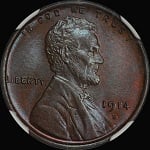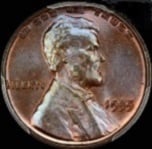What are your thoughts on this REEDED EDGE 1864-L Indian Cent?
I bought this coin many years ago and thought it was interesting so I decided to keep it for my private collection, thinking that it was probably hand or machine tooled by someone with too much time on their hands. I have some other interesting pieces, including a beautiful MS64 RB 1886 Indian cent with a nice clamshell rim, and an MS64 1861 with a large clipped planchet. Recently, I decided to have some of my private coins photographed by Todd/blucc (www.bluccphotos.com), including this neat 1865-L. Any way, Todd happened to show this coin to another forum friend who suggested it might have been minted from a foreign planchet. I don't know much about foreign planchet errors, so I thought I'd post this coin here for your comments. One of the photos has a regular Indian cent next to it for comparison. I also plan to bring it to Long Beach to show to a couple dealers who may have some knowledge as well. So please let me know what you think!












0



Comments
I agree it's very neat, though!
Worry is the interest you pay on a debt you may not owe.
"Paper money eventually returns to its intrinsic value---zero."----Voltaire
"Everything you say should be true, but not everything true should be said."----Voltaire
Greg Hansen, Melbourne, FL Click here for any current EBAY auctions Multiple "Circle of Trust" transactions over 14 years on forum
TRUTH
My thoughts ran to one of these three options:
1 - foreign planchet - lots of screwy darkside coins out there
2 - token planchet - weren't there a bunch of tokens produced during the war?
3 - mint pattern - 1864 was the year the IHC chanced from CN to BZ - maybe they were considering a different planchet entirely?
Having been lucky enough to see this in person, I just couldn't fathom that this was a post mint alteration. Which is what I emailed to Charmy. But both on this forum and on a Cointalk forum the overwhelming consensus is post mint alteration. Just goes to show what a rookie I am.
However this came to be, it is a very nice piece. Todd's images came out very well. Congratulations on the really neat coin Charmy!
I'd probably keep it in my collection away from the main stream, but cool to look at.
Truthteller's explaination makes the most sense,
but I'm not a machinist.
It is NOT a genuine Mint Error, Struck on a Token or Stuck
Foreign Planchet, or the result of being struck like that
in the US Mint.....
The only thing to discuss, if you're interested in minutea,
is exactly how it was made outside the Mint.
60 years into this hobby and I'm still working on my Lincoln set!
Any gun manufacturer from the Civil War era on would be able to create an example as such.
Neat.
"Keep your malarkey filter in good operating order" -Walter Breen
<< <i>This edge can be accomplished with a simple knurling tool on a lathe. Smaller diameter sacrifice stock is placed on either side of the host coin, (like a sandwich) the knurling tool can then be applied to create the reduced diameter decorative edge design.
Any gun manufacturer from the Civil War era on would be able to create an example as such.
Neat. >>
I can see that. Now that I understand a likely mechanism for the alteration, I'm with the post mint alteration camp. Thank you WoodenJefferson!
It almost looks to be shaped like it's set in a bezel. I wonder if that was the engravers intention....???
Cool piece.
-wes
Too many positive BST transactions with too many members to list.
<< <i>It almost looks to be shaped like it's set in a bezel. I wonder if that was the engravers intention....???
Cool piece.
-wes >>
Thank you all so much for your replies and opinions, especially Fred Weinberg (error guru) and Rick Snow (Indian cent guru)! I believe the reeding was performed directly on the coin over where the denticals used to be and is not an added attachment. Here are more close up photos that Todd took, including one of the cool reverse die crack. And yes, this coin isn't going anywhere - it's staying in my own collection.
The Penny Lady®
<< <i>Can you weigh it? (just for laughs) >>
Todd still has the coin and will bring it back to me at Long Beach, so I can't weigh it but that's a good idea - I will weigh it when I get it back.
The Penny Lady®
<< <i>
<< <i>Can you weigh it? (just for laughs) >>
Todd still has the coin and will bring it back to me at Long Beach, so I can't weigh it but that's a good idea - I will weigh it when I get it back. >>
I dont think I have anything good at home to weigh it, but will give it a shot.
``https://ebay.us/m/KxolR5
Charmy Harker
The Penny Lady®
Knurling is commonly done on a lathe in a machine shop. This coin was obviously done by hand by a skilled craftsman in the pre machine tool days. Very similar to the old " hand checkering " that gunsmiths do. Pure art and skilled hands.....and a dying skill at that with the age of modern CNC exquipment. Franks pic is that of a knurling head that goes into a CNC or manual lathe, and is adjustable to fit the diameter of the workpiece.
how much smaller in diameter than other ihc's is it?
how about the rim width?
the reason I ask is the denticles seem very short
and my first impression looking at it was that it was not an authentic coin
(mainly because of the parallel die cracks on the reverse and the doubling on the obverse)
The Penny Lady®